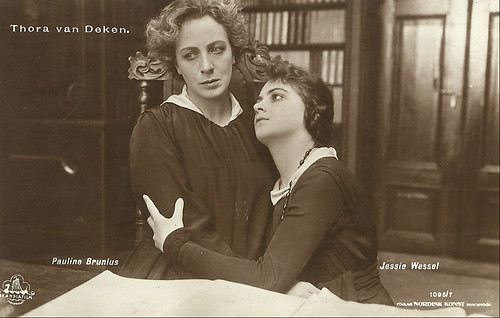
Swedish postcard by Verlag Nordisk Konst, Stockholm, no. 1095/7. Photo: Skandia Film. Pauline Brunius and Jessie Wessel in Thora van Deken (John W. Brunius, 1920).

Swedish postcard by Förlag Nordisk Konst, Stockholm, no. 1096/5. Photo: Skandia Film. Gösta Ekman and Pauline Brunius in the comedy Gyurkovicsarna/Lieutenant Tophat (John W. Brunius, 1920).

Swedish postcard by Axel Eliassons Konstförlag, Stockholm, no. 291. Photo: Skandia-Film. Pauline Brunius and Paul Seelig in En vildfågel/Give Me My Son (John W. Brunius, 1921). Adapted from the play 'Skeppsbrott' (Shipwreck) by Samuel A. Duse. The title means literally 'The Wild Bird'. On 3 October 1921, En vildfågel premiered simultaneously in five cinemas in five different Swedish cities.

Swedish postcard by Verlag Nordisk Konst, Stockholm, no. 1095/12. Photo: Skandia Film. Pauline Brunius in Thora van Deken (John W. Brunius, 1920).
Extremely successful in queen roles
Pauline Brunius was born Emma Maria Pauline Lindstedt in 1881 in Stockholm, the capital of Sweden. She started as a ballet girl at the Opera in 1891 where she spent ten years. From 1899 to 1902, she had private acting lessons from actress Lotten Dorsch. In 1902, she made her debut as an actress at the Olympiateatern.
During the early 20th century, Pauline Brunius acted in Stockholm's major theatres, the Svenska Teatern, Vasateatern and Dramaten. She was considered 'The Queen of Swedish Theatre'. At Svensk filmdatabas, Mikaela Lindblom described her in 2012 as "a classically-educated actress with a magnificent posture, had a melodic voice and was extremely successful in queen roles." From 1926 to 1932, she was the managing director of the Oscarsteatern together with her husband, actor and film director John W. Brunius and with star actor Gösta Ekman. They changed the Operetta theatre into a respected and innovative scene for stage plays.
Pauline Brunius acted in only 13 film roles. Her cinema career started with Thora van Deken/A Mother's Fight (John W. Brunius, 1920), also with Gösta Ekman. The film was based on a short story by Henrik Pontoppidan about a divorced wife of a wealthy landowner who lies in court that her deceased ex-husband had destroyed his will to secure her daughter's inheritance. In 1914, Brunius had already performed this role on stage and the film focuses on her standout performance. Brunius would be paired again with Gösta Ekman in Gyurkovicsarna/Lieutenant Tophat (1920) - also with Nils Asther, Kärlekens ögon/A Scarlet Angel (1922), Karl XII/Charles XII (1925), and Gustaf Wasa del I/Gustaf Wasa, Part One (1928), always directed by her husband, John W. Brunius.
The silent historical film Karl XII/Charles XII (John W. Brunius, 1925) was released in two separate parts because of its long-running time of nearly six hours. The film depicts the life of Charles XII of Sweden (1682-1718) who oversaw the expansion of the Swedish Empire until its defeat at the Battle of Poltava. It was the most expensive production in Swedish history when it was made, and inspired a string of large-budget Swedish historical films. Pauline Brunius also acted opposite Renée Björling in En vildfågel/Give Me My Son (John W. Brunius, 1921), and opposite Einar Hanson in Gunnar Hedes saga/Snowbound (Mauritz Stiller, 1923).
In 1930, she appeared in the sound film Charlotte Löwensköld (Gustaf Molander, 1930) featuring Birgit Sergelius. It is an adaptation of the 1925 novel Charlotte Löwensköld by Selma Lagerlöf. The film is almost entirely silent, with only brief dialogue sequences and a few sound effects. The film was not considered a success, and no further adaptations of Lagerlöf's work were made in her lifetime. Brunius co-starred with Victor Sjöström in his sound film Markurells i Wadköping/Father and Son (Victor Sjöström, 1931). However, Pauline Brunius is today best remembered in Sweden for her role as the high-class Mrs. Lindberg in the social comedy Karl Fredrik regerar/Karl Fredrik Reigns (Gustaf Edgren, 1934) with Sigurd Wallén.

Swedish postcard by Verlag Nordisk Konst, Stockholm, no. 1095/2. Photo: Skandia Film. Pauline Brunius and Hugo Björne in Thora van Deken (John W. Brunius, 1920).
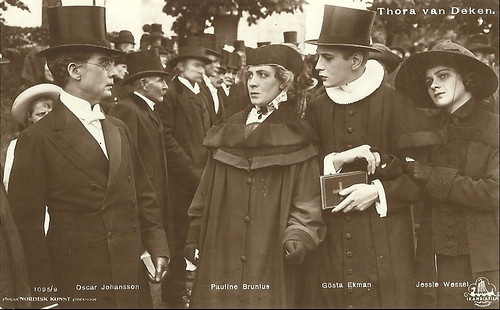
Swedish postcard by Verlag Nordisk Konst, Stockholm, no. 1095/9. Photo: Skandia Film. Pauline Brunius, Gösta Ekman, Jessie Wessel and Oscar Johansson in Thora van Deken (John W. Brunius, 1920).
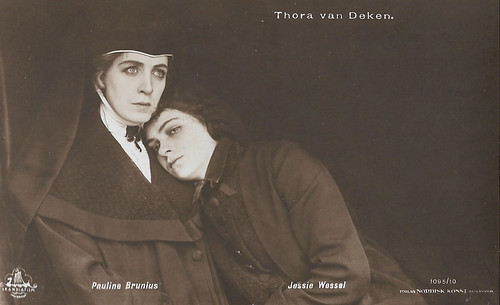
Swedish postcard by Verlag Nordisk Konst, Stockholm, no. 1095/10. Photo: Skandia Film. Pauline Brunius and Jessie Wessel in Thora van Deken (John W. Brunius, 1920).

Swedish postcard by Verlag Nordisk Konst, Stockholm. no. 1095/11. Photo: Skandia Film. Pauline Brunius in Thora van Deken (John W. Brunius, 1920).
Ten stormy years of stage direction
In the 1920s, Pauline Brunius made a series of short comedies based on her own scripts about the charming Stockholm family Vinner. The series started with Trollsländan/The Dragonfly (Pauline Brunius, 1920). The parents were played by the true couple Frida and Olof Winnerstrand and the son Putte by Brunius' son Palle. Six episodes were made that were shown as short films at the cinema and reminded of the current situation and action comedies. Fragments are preserved from De läckra skaldjuren/The Delicious Shellfish (Pauline Brunius, 1920) and Herr Vinners stenåldersdröm/Mr. Winner's Stone Age Dream (Pauline Brunius, 1924), plus a complete version of Lev livet leende/Laugh Live Smile (Pauline Brunius, 1921).
In co-operation with her husband, Pauline Brunius directed her only feature, Falska Greta/The False Greta (John W. Brunius, Pauline Brunius, 1934). The film was inspired by the obsession with Greta Garbo's Swedish visit in 1928. The script is kept in the Swedish Film Institute's library. Svenska Film's production manager Vilhelm Bryde approved of making the film with the addition of "an entertaining summer anniversary".
In the end, the script was filmed without Svenska's participation in Finland as a Swedish-Finnish co-production. The film, with Karin Albihn playing the title role, is today considered lost. Brunius henceforth dedicated herself exclusively to the theatre. In 1938, Pauline Brunius was the first woman, who was appointed managing director of Dramaten, the Royal Dramatic Theatre in Stockholm, since its opening in 1788. She succeeded Olof Molander, who had ruled Dramaten with an iron hand.
Brunius had ten stormy years at Dramaten. Leading Sweden's national theatre through the years of the Second World War can't have been easy. She was criticised for a performance by Dramaten in Berlin in 1941. Under Brunius' leadership, Marika Stiernstedt's anti-Nazi play Attentat (The Attack) was staged by Alf Sjöberg in 1944. She was praised for her consciously strong initiative at Dramaten and for her initiative to build a second stage, the Little Stage, to increase the competitiveness and capacity of the national theatre. In 1948, she resigned due to illness.
In 1954, Pauline Brunius died in Stockholm at the age of 73. She had been married to John W. Brunius from 1909 till 1935. Their children were actress Anne-Marie Brunius and actor Palle Brunius. Director Nils Brunius is Pauline Brunius's grandson.
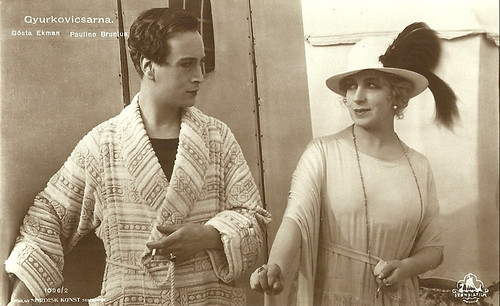
Swedish postcard by Forlag Nordisk Konst, Stockholm, no. 1096/2. Photo: Skandia Film. Gösta Ekman and Pauline Brunius in Gyurkovicsarna/Lieutenant Tophat (John W. Brunius, 1920).
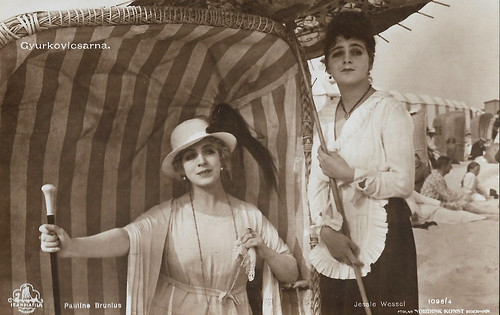
Swedish postcard by Förlag Nordisk Konst, Stockholm, no. 1096/4. Photo: Skandia Film. Pauline Brunius and Jessie Wessel in the comedy Gyurkovicsarna/Lieutenant Tophat (John W. Brunius, 1920).

Swedish postcard by Förlag Nordisk Konst, Stockholm, no. 1096/6. Photo: Skandia Film. Gösta Ekman and Pauline Brunius in the comedy Gyurkovicsarna/Lieutenant Tophat (John W. Brunius, 1920).

Swedish postcard by Axel Eliassons Konstförlag, Stockholm, no. 288. Photo: Skandia-Film. Pauline Brunius, Tore Svennberg, Renée Björling and Paul Seelig in the Swedish silent drama En vildfågel/Give Me My Son (John W. Brunius, 1921). Adapted from the play 'Skeppsbrott' (Shipwreck) by Samuel A. Duse. The title means literally 'The Wild Bird'. On 3 October 1921, En vildfågel premiered simultaneously in five cinemas in five different Swedish cities.

Swedish postcard by Axel Eliassons Konstförlag, Stockholm, no. 289. Photo: Skandia-Film. Pauline Brunius and Paul Seelig in the Swedish silent drama En vildfågel/Give Me My Son (John W. Brunius, 1921).
Source: Mikaela Kindblom (Svenska Filminstitutet/Svensk filmdatabas - Swedish), Julie Rongved Amundsen (Store norske leksikon- Norwegian), Mette Hjort and Ursula Lindqvist (A Companion to Nordic Cinema), Wikipedia (English and Swedish), and IMDb.
This post was last updated on 19 August 2023.
No comments:
Post a Comment